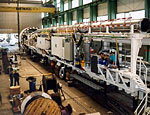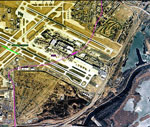By Dan Olson, Minnesota Public Radio
August 16, 2001
|
|
RealAudio |
A tunnel-boring machine the length of a football field arrives by ship in Duluth Friday. Beginning this fall, the 500 ton German-made machine will dig parallel tunnels beneath the Twin Cities airport for the Hiawatha light-rail line.
| |
|
|
|
||
The Hiawatha light-rail line will run above ground for most of its 11.5-mile length from downtown Minneapolis to the Mall of America. At the airport the line will descend 70 feet into parallel, 1.7-mile-long tunnels. Mosites says the business end of the tunnel boring machine is a rotating wheel 21 feet in diameter with blades.
"The tunnel-boring machine will actually be boring into St. Peter sandstone once it's below ground, and it'll between two water tables which in essence is a dry area," according to Mosites.
Geologists describe St. Peter sandstone as soft enough to carve with a spoon. Beneath most of the Twin Cities, it's sandwiched between two layers of limestone in a geologic structure consultants say is ideal for tunneling.
Mosites says the machine isn't exactly a speed demon. It'll carve about 70 feet of tunnel a day. Creating the twin tunnels will take about a year. Mosites says workers at the mouth of the tunnel will guide round sections of concrete through the machine to create the tunnel wall.
| |
|
|
|
||
The tunnel-boring crew includes a driver who Mosites says sits in a room near the front end of the machine, at a keyboard, with a global positioning system and a screen displaying a target that guides the progress of the machine.
There'll be at least a couple of white-knuckle days for the tunnel builders. The sandstone geology underneath the airport is consistent with one exception: there's a 300-foot-long stretch where the bedrock has collapsed. Mosites says the risk of a cave-in is remote. "Above ground we'll be basically having a moving work zone to keep aircraft out of that area just in case of the thing that shouldn't happen, but just in case we'll keep aircraft out of that area to avoid any potential problems."
Smaller tunnel-boring machines are used to create Twin City sewer lines. Mosites says the 500 ton, 100-yard-long machine is the largest ever used in the state. Moving it from Duluth to the Twin Cities will be a spectacle that will happen when most people are asleep. Mosites says Virginia, Minnesota-based Kirscher Trucking, a company with experience in moving mining equipment, will haul sections of the machine Monday night on Interstate 35 from Duluth to the Twin Cities on two trucks travelling side by side, escorted by state troopers.
The two tunnels and two underground stations at the airport will cost about $142 million, making it the most expensive portion of the $675 million Hiawatha light-rail project. Tunneling begins in October. The first light-rail service is scheduled for 2003.


